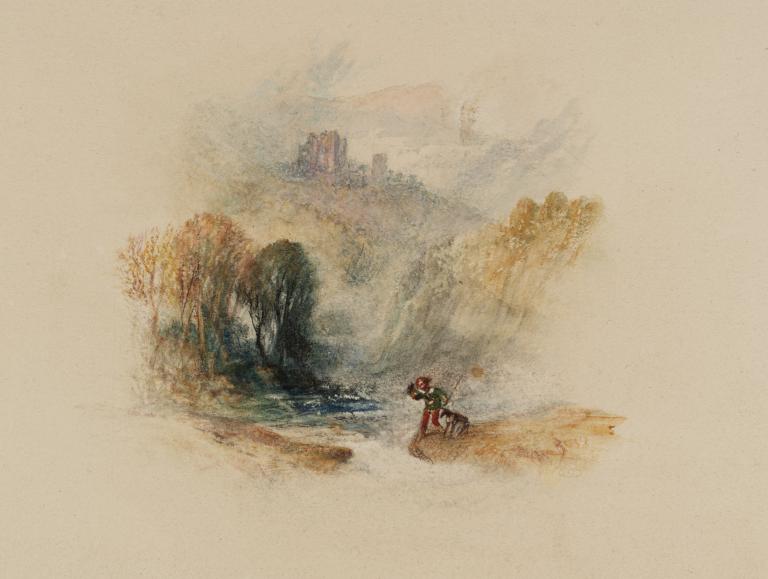Joseph Mallord William Turner The Boy of Egremond, for Rogers's 'Poems' c.1830-2
Joseph Mallord William Turner,
The Boy of Egremond, for Rogers's 'Poems'
c.1830-2
Joseph Mallord William Turner 1775–1851
The Boy of Egremond, for Rogers’s ‘Poems’ circa 1830–2
D27695
Turner Bequest CCLXXX 178
Turner Bequest CCLXXX 178
Watercolour, approximately 115 x 108 mm on white wove paper, 238 x 306 mm
Inscribed by ?the engraver ‘x’ top centre
Stamped in black ‘CCLXXX 178’
Inscribed by ?the engraver ‘x’ top centre
Stamped in black ‘CCLXXX 178’
Accepted by the nation as part of the Turner Bequest 1856
Exhibition history
1904
National Gallery, London, various dates to at least 1904 (237).
1936
Four Screens, British Museum, London, July 1936–February 1937 (no catalogue but numbered 6).
1980
Turner in Yorkshire, York City Art Gallery, June–July 1980 (150, reproduced, as ‘The Strid with Barden Tower’).
References
1903
E.T. Cook and Alexander Wedderburn (eds.), Library Edition: The Works of John Ruskin: Volume I: Early Prose Writings 1834–1843, London 1903, pp.233, 244.
1904
E.T. Cook and Alexander Wedderburn (eds.), Library Edition: The Works of John Ruskin: Volume XIII: Turner: The Harbours of England; Catalogues and Notes, London 1904, pp.380–1.
1906
E.T. Cook and Alexander Wedderburn (eds.), Library Edition: The Works of John Ruskin: Volume XXI: The Ruskin Art Collection at Oxford, London 1906, p.214.
1909
A.J. Finberg, A Complete Inventory of the Drawings in the Turner Bequest, London 1909, vol.II, p.902, as ‘The Boy of Egremont’.
1966
Adele Holcomb, ‘J.M.W. Turner’s Illustrations to the Poets’, unpublished Ph.D thesis, University of California, Los Angeles 1966, pp.83, 88, as ‘The Boy of Egremont’.
1979
Andrew Wilton, The Life and Work of J.M.W. Turner, Fribourg 1979, pp.442–3 no.1197, reproduced.
1980
David Hill, Stanley Warburton, Mary Tussey and others, Turner in Yorkshire, exhibition catalogue, York City Art Gallery 1980, p.95, no.150 as ‘The Strid with Barden Tower’, reproduced.
1993
Jan Piggott, Turner’s Vignettes, exhibition catalogue, Tate Gallery, London 1993, p.97.
This vignette, The Boy of Egremond was published in the 1834 edition of Rogers’s Poems and appears as the head-piece to a poem of the same title.1 The engraver was Edward Goodall.2 Rogers’s poem tells of the son of twelfth-century noble William Fitz Duncan. Popularly known as the ‘Boy of Egremond’ (or Egremont), the youngster drowned while crossing the River Wharfe in Yorkshire at a narrow and especially turbulent point, which as Turner notes in the margin of his own copy of the 1827 edition of Poems is known as the ‘Strid’ (see Tate D36330; Turner Bequest CCCLXVI p.203).3 The poet recounts the tale with overflowing sentiment:
In tartan clad and forest-green,
With hound in leash and hawk in hood,
The Boy of Egremond was seen.
Blithe was his song, a song of yore
But where the rock is rent in two,
And the river rushes through,
His voice was heard no more!
’Twas but a step! the gulf he passed;
But that step – it was his last!
As through the mist he winged his way,
(A cloud that hovers night and day,)
The hound hung back, and back he drew
The Master and his merlin too.
That narrow place of noise and strife
Received their little all of Life!
(Poems, p.185)
With hound in leash and hawk in hood,
The Boy of Egremond was seen.
Blithe was his song, a song of yore
But where the rock is rent in two,
And the river rushes through,
His voice was heard no more!
’Twas but a step! the gulf he passed;
But that step – it was his last!
As through the mist he winged his way,
(A cloud that hovers night and day,)
The hound hung back, and back he drew
The Master and his merlin too.
That narrow place of noise and strife
Received their little all of Life!
(Poems, p.185)
Turner’s illustration shows the young boy accompanied by his hound and hawk about to embark on his ill-fated crossing. The composition appears to be derived from a small pencil thumbnail sketch which the artist made in the margin of his working copy of the book (see Tate D36330; Turner Bequest CCCLXVI p.203). In addition Turner also made a tiny drawing of a large building with square towers and walls. This appears to be Bolton Castle, the medieval ruins which appear in the background of the finished vignette (see Tate D36330; Turner Bequest CCCLXVI p.202). The rest of the backdrop is a dramatic view of the North Yorkshire landscape, a part of the country with which Turner was very familiar, having visited the area several times between 1797 and 1825. Topographical sketches featuring the Wharfedale valley, for example, can be found in the Devonshire Rivers No.3 and Wharfedale sketchbook (Turner Bequest CXXXIV), Hastings sketchbook (Turner Bequest CXXXIX), Yorkshire 2 and Yorkshire 5 sketchbooks (Turner Bequest CXLV and CXLVIII), and the Farnley sketchbook (Turner Bequest CLIII). He also made one large detailed drawing to which he may have referred, The Strid, Bolton Woods (see Tate D12119; Turner Bequest CLIV U).
The picturesque setting and soft palette of the vignette belie the tragic events of the poem. As an expression of her grief, the boy’s mother, Alice de Romilly, commissioned Bolton Abbey to be built downstream of the Strid. The abbey forms the subject of Turner’s second illustration for this poem see Tate D27696; Turner Bequest CCLXXX 179).
W.G. Rawlinson, The Engraved Work of J.M.W. Turner, R.A., vol.II, London 1913, no.393. There is one impression in Tate’s collection (T05120).
Verso:
Inscribed by unknown hands in pencil ‘NG’ and ‘27’ top centre [Pasted to mount]
Inscribed by unknown hands in pencil ‘NG’ and ‘27’ top centre [Pasted to mount]
Meredith Gamer
August 2006
How to cite
Meredith Gamer, ‘The Boy of Egremond, for Rogers’s ‘Poems’ c.1830–2 by Joseph Mallord William Turner’, catalogue entry, August 2006, in David Blayney Brown (ed.), J.M.W. Turner: Sketchbooks, Drawings and Watercolours, Tate Research Publication, December 2012, https://www

